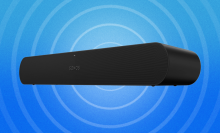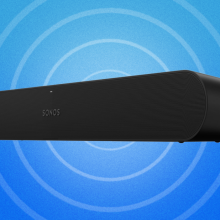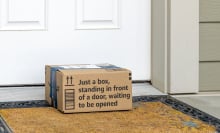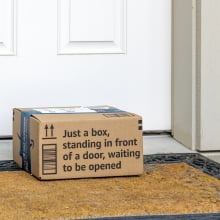Table of Contents
The conversation surrounding the best robot vacuums is a multi-faceted one in which at least five brands have a word at any given moment, fluctuating every few months as someone releases yet another new model. Regardless of the competition, the Shark vs. Roomba debate is forever a heated one — exemplified when even a generic search of "robot vacuum" on Google triggers the "People also ask" box to populate with "Is Shark or iRobot better?"
Cementing a definitive answer on the better robot vacuum brand is tricky when "better" is a subjective take swayed by what a shopper needs their robot vacuum to excel at. Some may consider the better robot vacuum to have more advanced features or stronger suction, while others may classify the one that squeezes out a decently-thorough clean for less money to be the better value.
There are a few comparison angles that make some models a draw, like in the low-to-mid range mopping category: Models like the iRobot Roomba Combo i5 and i5+, Shark Matrix Plus 2-in-1, and Shark Matrix RV2400W can mop and smart map, available in a standalone version for between $200 and $300 and a self-emptying version between $350 and $500. Prices are subject to change depending on the retailer, and in Shark's case, are only available at Walmart, depending on the model.
Also keep in mind that neither Shark nor Roomba measures suction power in Pascals (Pa) like most of their competitors do. Both insist on keeping an air of mystery by solely comparing suction power to other vacuums in their own family tree. (Though Shark has been known to make claims like "50% better suction than the best-selling iRobot." Whatever that means — the weakest Roomba is probably technically one of its best sellers.)
Where Roomba wins: Small obstacle avoidance and more models to fit more needs
iRobot simply has more robot vacuums, and that variety alone gives it a leg up on Shark. More models to choose from means more opportunities to customize the features and budget to a shopper's main goals for automated cleaning.
Let's say you're willing to pay a little extra for a premium robot vacuum that achieves the most hands-off experience possible. iRobot has more than one option with two perceptive automation features to significantly down the need for human intervention in the cleaning process: a built-in, retractable mopping arm and a small obstacle avoidance camera.
The built-in mopping mechanism is what makes the Combo j7+ and Combo j9+ true 2-in-1 robot vacuums, and what sets them apart from other Roomba Combos. The built-in mopping arm lives in the robot vacuum 24/7, extends to mop on hard floors, and automatically lifts above the vacuum when carpet is sensed.
But floor type is far from the most impressive thing that the Combo j7+ or j9+ can correctly recognize. Small obstacle avoidance technology solves the main gripe that many robot vacuum non-believers have: robot vacuums get stuck so often that they're more trouble than they're worth. An LED light and camera combo on the front of all j Series Roombas helps them see small obstacles that less-advanced robot vacuums would typically eat, like a phone charger, extension cord, rogue sock, or pet waste.
I first experienced this sense of relief when reviewing the Roomba j7+ and Combo j7+, and it was never easy to get back into the habit of pre-tidying when trying another robot vacuum that didn't have that. I'd easily sacrifice more intense cleaning for a robot vacuum to have the brain cells to do that.
One of the coolest parts about the Roomba lineup is that you can mix and match several of these features to stay within a certain budget. You can score the ability to detect phone chargers and pet waste on any j Series Roomba. Get it without the fancy mop situation for as low as $299 on sale with the standalone Roomba j5, settle for the mop that needs to be manually clicked on and off while still securing self-emptying with the Roomba Combo j5+ for as low as $449 on sale, plus several options in between.
If you can live without small obstacle avoidance but would still prefer mopping, the Combo i Series Roombas have you covered. If you're in this category of budget shopper, though, scroll down to find out why a Shark might do more for your buck.
FWIW, the Roomba j Series self-empty docks are more palatable than Shark self-empty docks. If you care about subtly, the Roomba Combo j9+ and its wooden accents in particular blend in nicely in my living room that's not high tech-y at all. The compactness and chic-ness of the Combo j9+ dock is even more impressive upon remembering that it's housing a bag for automatically-emptied debris as well as a large water tank that automatically refills the water tank on the bot itself. Shark doesn't offer anything like the latter.

Where Roomba loses: Overpriced "cheap" models
Anyone pressed on staying at the low end of the pricing spectrum can just step to the Shark side now, because the Roomba robot vacuums that drop below $200 just aren't up to par.
Don't let almost 30,000 reviews at Amazon fool you — the 600 Series Roombas (namely the 692 and 694) haven't aged well. Even on sale, they still don't get cheap enough to justify a lack of smart mapping when a similarly-priced Shark RV2300 or RV2310 has it. In my experience, the Roomba 694's zigzag pattern feels like a hit-or-miss guessing game made more annoying by getting stuck and missing spots on the floor that I'd rather just hit with my Dyson, anyway.

In April 2024, iRobot fumbled a low-hanging opportunity to right the disappointments of its budget section. The new $249.99 Vac Essential and $274.99 Roomba Combo Essential that mops do provide a more powerful clean than the older 600 Series, but the cheap Roomba's fatal flaw remains: they still don't have smart mapping. A handful of sub-$300 Sharks with suction power I found to be comparable do smart map. Case closed.
In its next round of Roomba releases, iRobot would also be wise to drop a more budget-friendly option with carpet-centric suction power. For homes with pets, the Combo j9+ is really the only Roomba that can be trusted to deal with serious matted-down shedding. (It's the most powerful Roomba to date and has 100 percent better suction power than the i Series Roombas.) And at $999.99 at its lowest, it's not exactly a casual investment.
I'd also consider skipping any j Series Roomba that's not the Combo j9+ on the sole basis that the whoosh of the automatic emptying dock takes a year off my life every time it goes off. (iRobot amended that issue with the Combo j9+.) The self-emptying Sharks I've used are much more muffled when transferring debris from the bot to the dock.
Where Shark wins: Spot cleaning and affordability
I have both my beloved cordless Dyson and, for Mashable testing purposes, at least one robot vacuum at my fingertips at all time. I've been able to trust most 2023 and 2024 models to successfully give the rooms to which I send them a light dusting, at least satisfactorily enough to not use the Dyson every single day.
But I get a true sense of any given robot vacuum's value when an unexpected mess within one of those rooms needs to be taken care of right now. Is my instinct to pick up my phone and send the robot vacuum to that specific spot, or is its zone cleaning process convoluted enough to make me grab my Dyson without a second thought?
Shark Matrix robot vacuums make spot cleaning easier than Roombas do. While the iRobot app insists that you create and name an official cleaning zone even if this is a one-time thing, Shark lets you skip the labeling charade to drag and drop a square on your map in the designated spot cleaning tab. It's just one step, but there's something to be said for streamlining.
Shark also gets a bit more nitty gritty with the spot cleaning itself. The claim to fame of its latest Matrix line is, you guessed it, Matrix Clean: In this mode, the Shark cleans in a grid pattern, approaching the area several times from multiple angles to grab anything it may have missed in the first pass or two. I don't know if it was this or suction power, but the Shark Matrix Plus 2-in-1 and Shark Detect Pro were much less likely to miss a crumb on a rug than the Roomba Combo j7+, which is slightly more expensive.

During regular vacuuming, Sharks in Matrix mode dish out 30 percent better carpet cleaning than the older RV Shark models. For the 2-in-1 Shark models, Matrix mode works with mopping, too, when the mopping pad vibrates 100 times per minute to scrub at stains that likely wouldn't budge when wiped with a stationary cloth. Matrix mopping came in clutch for keeping up with the constant layer of shoe prints by my front door.
Shark even extends the Matrix cleaning mechanism to its cheapest robot vacuum, making it one of our favorite — if not actual favorite — budget-friendly robot vacuums in 2024. The Shark RV2310 and Walmart-exclusive Shark Matrix RV2300 and RV2300S are incredibly reliable robot vacuums for the price, often on sale for $199.99 for the standalone version and $299.99 for the self-emptying version. (If this model is sold and shipped by a third party that's not Walmart when you click, we'd advise to wait until more stock from Shark itself comes in.)

Considering that the sub-$200 and -$300 Roombas skip smart mapping altogether (subsequently also skipping zone cleaning), this Shark model being able to clean specific rooms on command is a pretty rare find. I experienced no noteworthy issues with navigational accuracy when sending the Shark RV2300 to specifically sweep my bathroom or Matrix clean the floor surrounding the kitchen counter, which is an area I dragged and dropped in the app on a case by case basis. Though the suction power is expectedly just OK, it was enough for surface-level daily upkeep of the big, visible debris.
Where Shark loses: Advanced self-sufficiency features
Shark's robot vacuum blind spot is essentially the same one hindering its cordless vacuum lineup from beating Dyson. It's the fact that any sort of advanced features fall off after the $500-ish mark.
The most premium Shark robot vacuum, the $649.99 (or $449.99 on sale) Shark Matrix Plus 2-in-1 does hit the big three bullet points: self-emptying, forceful mopping, and smart mapping. However, it doesn't do either of the latter two things as autonomously as several premium Roombas do.
While it is able to recognize rooms, furniture, or virtual zones that you've set in the app, the nicest Shark robot vacuum still doesn't isn't armed with the cameras needed to recognize small obstacles like cords or pet toys or slippers — meaning you have to be around to clear the floor of those before sending a Shark out. One Roomba counterpart, the $649.99 (or $499 on sale) Roomba Combo j5+, also self-empties, mops, and maps, and does the last part with small obstacle avoidance built in to take on a job even if the floor is a little chaotic. Compared to the other main brands like iRobot, Roborock, Eufy, Ecovacs, and Narwal, Shark is the only one that doesn't offer a single bot with small obstacle avoidance.
Unlike the Roomba Combo j7 and j9 Series, none of the hybrid Sharks automatically stop mopping when carpet is sensed. This means vacuum and mop mode aren't possible at the same time, and that a person needs to manually attach the water tank to switch to mopping mode. With Matrix Mopping being such a solid feature, it's a bummer that it can't be deployed more freely.

Though I was satisfied with the floor coverage, thoroughness, and mapping accuracy when testing the $599.99 Shark Detect Pro, it seems overpriced for the negligible differences between it and a regular old self-emptying Shark. "Detect" sounds like it should refer to the capability to detect phone chargers or socks, but alas, it's actually talking about a feature that increases suction when an edge, corner, or extra dirty spot is detected. This is nice, but heightened corner coverage isn't major enough to justify $600, especially when there are several Roombas in this price range that also work harder on dirtier spots, as well as mop and avoid small obstacles.




















